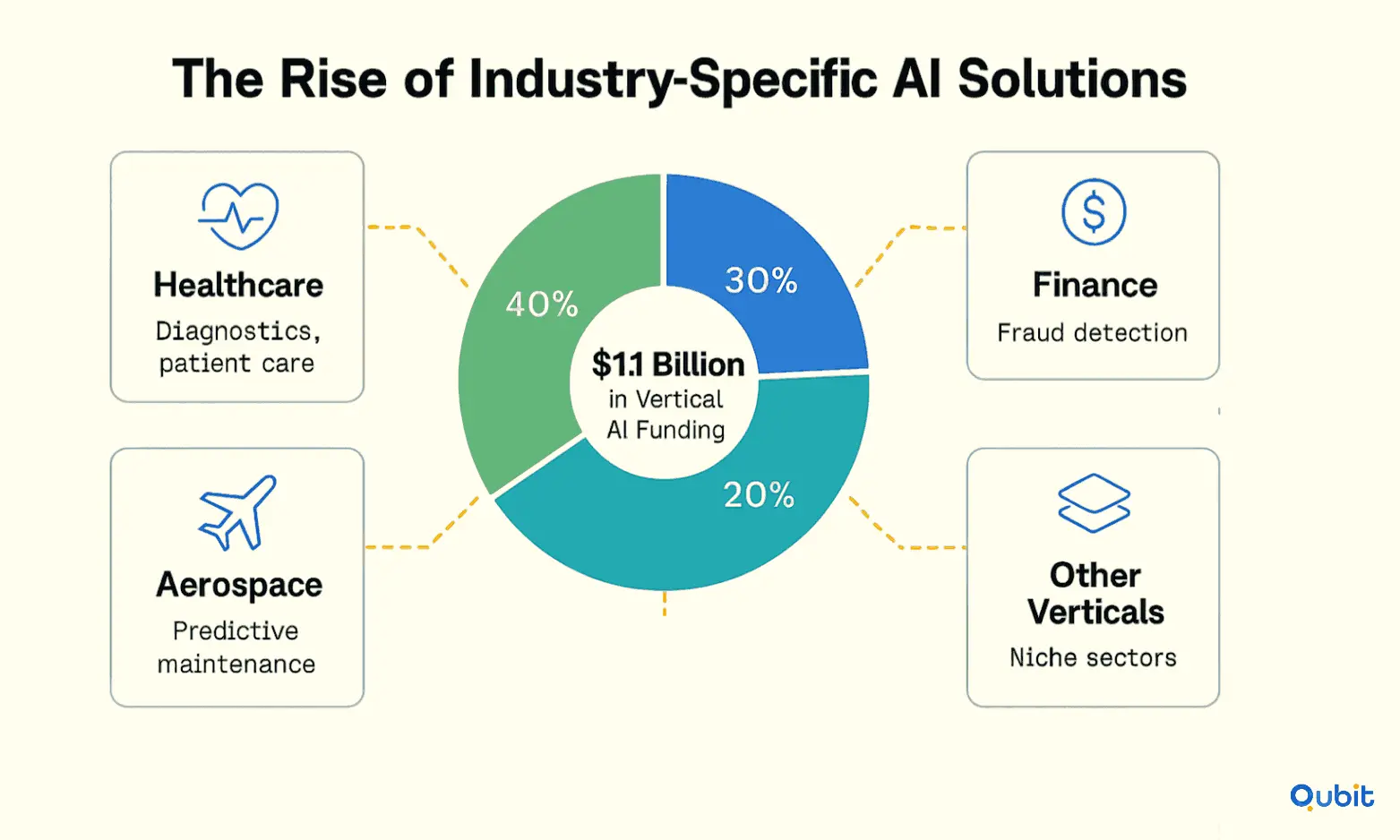2025 has emerged as a landmark year for funding in AI-driven SaaS platforms. Investor enthusiasm is at an all-time high, fueled by rapid advancements in generative AI and the growing demand for automation across industries. This momentum is reflected in the volume and size of funding rounds, with both early-stage startups and established players attracting significant capital. As AI capabilities become more sophisticated and industry adoption accelerates, the funding landscape for SaaS platforms is experiencing a notable transformation, setting new benchmarks for growth and innovation
This blog delves into the funding momentum behind AI-driven SaaS platforms, offering data-driven insights and emerging trends. Your exploration of AI-driven SaaS funding is enriched by the comprehensive insights on software startup fundraising strategies, which detail overarching approaches within the software start-up landscape.
Let’s jump right in to uncover how AI is shaping the future of SaaS funding.
2025 Funding Trends: Data and Insights
Investment in AI-driven SaaS platforms is reaching new heights in 2025. Key trends include:
- Increased deal volume: The number of funding rounds for AI SaaS startups has grown compared to previous years, indicating sustained investor confidence.
- Larger average deal sizes: Investors are writing bigger checks, especially for companies demonstrating strong product-market fit and scalable AI solutions.
- Sector-specific momentum: Industries such as healthcare, finance, and aerospace are attracting targeted investments, with vertical SaaS solutions seeing a surge in funding.
- Active investors: Leading venture capital firms are focusing on AI SaaS, often participating in multiple rounds across different verticals.
These trends underscore a shift in investor priorities, with a strong emphasis on scalability, vertical specialization, and ethical AI practices as key criteria for funding decisions.
What’s Fueling the Funding Momentum?
Multiple factors are driving the surge in AI SaaS funding in 2025:
- Breakthroughs in generative AI: New capabilities are enabling SaaS platforms to offer unprecedented personalization, automation, and decision support.
- Enterprise adoption: Large organizations are accelerating their integration of AI-powered SaaS, seeking efficiency gains and competitive advantages.
- Regulatory clarity: Evolving standards around AI ethics and data governance are increasing investor confidence by reducing perceived risks.
- Market demand: Businesses across sectors are prioritizing digital transformation, fueling demand for AI-driven solutions that can scale and adapt to changing needs.
Vertical Specialization in AI
Artificial intelligence is reshaping industries by diving deep into sector-specific challenges, a trend known as vertical specialization. This approach is driving significant investment, particularly in industries like healthcare, finance, and aerospace, where tailored AI solutions are proving transformative.
The Rise of Industry-Specific AI Solutions

Vertical specialization in AI focuses on creating solutions that address the unique needs of specific sectors. For example, healthcare AI applications are revolutionizing diagnostics and patient care, while financial AI tools are enhancing fraud detection and risk management. Aerospace, too, is leveraging AI for predictive maintenance and optimizing flight operations.
Investor interest in these niche markets is surging. A recent statistic highlights that $1.1 billion has been funneled into vertical AI funding, underscoring the growing demand for industry-specific innovations.
Sector-specific nuances are illuminated through vertical SaaS funding trends, offering a detailed view of how AI is shaping investment opportunities in targeted industries.
Identifying Problems and Potential Risks in AI Deployment
The rapid adoption of artificial intelligence (AI) has brought transformative opportunities, but it also introduces a range of challenges. From escalating privacy concerns to the unintended consequences of biased algorithms, organizations must address these risks to ensure responsible AI deployment. Below, we outline the key challenges associated with AI implementation:
- Privacy and Security Issues: The increased reliance on vast datasets has heightened the risk of data breaches and unauthorized access. Sensitive information, if mishandled, can lead to significant reputational and financial damage.
- Shortage of Skilled AI Professionals: The demand for AI expertise far exceeds the current supply, creating a talent gap that slows innovation and complicates implementation.
- Unintended Biases in AI Models: AI systems often reflect the biases present in their training data, leading to unfair or discriminatory outcomes. These biases can undermine trust and result in regulatory scrutiny.
- Regulatory Hurdles: As governments and organizations work to establish ethical AI standards, navigating complex and evolving regulations becomes a critical challenge for businesses.
Addressing these risks requires a proactive approach, combining robust data governance, investment in talent development, and a commitment to ethical AI practices.
Evaluating Investment Opportunities in AI-Driven SaaS
Identifying promising AI-driven SaaS startups requires a careful examination of several critical factors. Investors and founders alike must focus on scalability, market potential, and ethical AI practices to ensure sustainable growth and long-term success.
1. Scalability: The Foundation of Growth
Scalability is a non-negotiable criterion when evaluating AI SaaS startups. A scalable business model ensures that the company can handle increased demand without a proportional rise in costs. Key indicators of scalability include:
- Cloud Infrastructure: Startups leveraging cloud-based platforms can easily scale their operations to accommodate growth.
- Automation: AI SaaS solutions that automate repetitive tasks reduce operational bottlenecks, enabling seamless expansion.
- Subscription Models: Recurring revenue models, such as SaaS subscriptions, provide predictable cash flow, supporting scalability.
2. Market Potential: Assessing Demand and Competition
Understanding the market potential of an AI SaaS startup involves analyzing its target audience, industry trends, and competitive landscape. Investors should consider:
- Total Addressable Market (TAM): A large TAM indicates significant growth opportunities.
- Customer Retention Rates: High retention rates signal product-market fit and customer satisfaction.
- Emerging Trends: Aligning with broader software investment trends can provide valuable insights into market readiness and future demand.
3. Ethical AI Practices: Building Trust and Compliance
Ethical considerations are increasingly shaping the AI SaaS landscape. Startups that prioritize transparency, fairness, and compliance with data privacy regulations are better positioned to gain trust and avoid legal pitfalls. Key aspects to evaluate include:
- Bias Mitigation: AI models should be designed to minimize bias and ensure fairness.
- Data Privacy: Adherence to regulations like GDPR and CCPA demonstrates a commitment to protecting user data.
- Explainability: AI systems should provide clear, understandable outputs to foster user confidence.
By focusing on these criteria, investors can identify startups with the potential for sustainable growth, while founders can align their strategies to attract funding and build trust.
Actionable Strategies: How Startups Can Attract Funding in 2025
To stand out in the competitive 2025 funding landscape, AI SaaS startups should:
- Demonstrate scalability: Investors favor platforms that can efficiently scale operations and revenue without proportional cost increases.
- Showcase vertical expertise: Tailoring solutions to specific industries increases perceived value and funding potential.
- Prioritize ethical AI: Transparent, bias-mitigated, and privacy-compliant AI models build trust with both customers and investors.
- Leverage data-driven narratives: Use clear metrics and outcomes to illustrate traction and market fit.
Conclusion
Clear strategies and data-driven insights are essential for securing funding in the competitive realm of AI-driven SaaS platforms. Throughout this blog, we’ve explored actionable approaches that emphasize the importance of aligning your funding narrative with measurable outcomes and market demands. A well-defined perspective not only strengthens your pitch but also builds trust with potential investors.
At Qubit Capital, we understand the challenges startups face when crafting compelling funding strategies. If you're ready to elevate your approach, we invite you to explore our Fundraising Assistance service. Let us help you transform your vision into a reality.
Key Takeaways:
- AI-driven SaaS platforms are revolutionizing funding and innovation.
- Agentic AI and data-centric strategies are key growth drivers.
- Human-AI collaboration significantly boosts productivity.
- Vertical specialization and ethical standards are critical for investment success.
- Evaluating scalability and market potential is essential when considering investments.
Frequently asked Questions
What are the top AI SaaS startups in 2023?
Several AI SaaS startups have emerged as leaders in 2023, showcasing innovative solutions and impressive growth. Companies like OpenAI, Hugging Face, and DataRobot have gained significant traction, with OpenAI securing billions in funding and Hugging Face becoming a hub for AI model sharing. These startups are not only transforming industries but also setting benchmarks for AI-driven SaaS platforms.


 Back
Back



